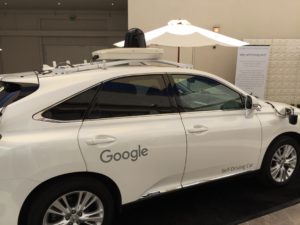The future is here! Google’s self-driving car is in our neighborhood by Zoe Richmond
Here’s a list of things my toddlers will never get to do: 1.) Make a mixed tape for a girl. 2.) Leave a goofy answering machine message. 3.) Drive a car.
The jury is still out on number 3. But with Google’s self-driving car testing in our neighborhood it feels like the future is here.

Google’s self-driving car on display at a recent community open house.
Months ago, my husband came home with some exciting commuter news. He had spotted a Google self-driving car in our Phoenix suburb of Chandler. Weeks later he brought home a picture of the self-driving SUV. So you can imagine my excitement when Google had an open house for our community to see the vehicle up close.
I loaded the kids up in their wagon and we headed out to see first-hand the revolution of transportation. Would they remember this moment the same way generations before remembered seeing the first automobile? Would it be as brilliant as watching the first space launch?
It was a bit lackluster compared to a space launch. The Google self-driving car was an unassuming white SUV, akin to the gaggle of mom-mobiles seen around our neighborhood. The only way to tell it apart from other vehicles was the labeled stickers on the side claiming “Google self-driving vehicle.” Oh, and the gigantic black orb on the top and multitude of sensor that surround the car.
But my mind was still giddy with possibilities. A self-driving car would be the new must-have item for any mom. Out of diapers? Send the car to pick some up. No time for dinner? Send the car for curb-side pick up. Kids acting out? No more reaching from the driver’s seat, just sit in the backseat while the car drives itself to your destination.
And it’s not just about convenience for mothers. Transportation trends are showing that Americans are starting to fall out of love with the automobile. Millennials are not getting driver’s licenses at the same rate as previous generations. Older citizens are looking for transportation alternatives beyond driving.
Why is Google embarking on this revolutionary testing? Have they seen the generational trends and they want to get ahead of the curve? Or do they just want to make my drive easier when I have two kids in the back seat?
“It’s all about safety,” said Lauren Whalley, a consultant working with Google. “Look at the statistics, last year more than 35,000 people were killed in car crashes.”
It’s true. You probably learn about several serious car crashes on your local news every day. Of all crashes, 94 percent involve human error and distracted driving. Transportation experts fear that this number will only increase as technology continues to be pervasive. Depending on the circumstances, driving your child to daycare may be the most dangerous activity you undertake.
Because the primary goal is to save lives, Google is not providing a date when a self-driving car will be available.
“We don’t have an artificial date because our focus is safety,” said Jennifer Haroon, Head of Business Operations for Google’s Self-Driving Car. “You won’t be waking up one day and they will be ubiquitous, it’s going to be rolled out slowly.”
They also don’t see it as revolutionary as my space shuttle launch analogy.
“It’s a progression of the technology,” said Haroon. “I equate it to an elevator. At first, we needed an individual to take us up and down buildings. As the technology advanced, people got comfortable with stepping into an elevator and pushing a button.”
As with any technology, there are certainly those that could be fearful of the self-driving vehicle in their neighborhood. But self-driving cars have a better safety record than the rest of us. So far the vehicles have driven more than 1.8 million miles. When a crash occurs with these cars, they usually happen because another driver has actually crashed into the driverless vehicle.
“Some people do have anxiety and I am amazed is how quickly that is over come,” said Harron. “They are amazed at all the aspects that the car sees. Then they find the ride is pretty boring, the car just drives itself. And I am surprised by how quickly they start to trust the technology, within 30 seconds they are relaxed.”
To determine it’s location, Google’s car uses a combination of detailed, 3D digital maps and an array of sensors that can see 360 degrees. The human field of vision is 120 degrees, and that can sometimes be hampered if the kids have plastered the windows with stickers. The software can recognize drivers, cyclists and pedestrians and because of the million miles of real world and simulated driving, Google’s car can anticipate how others may behave.
On top of that, the car is programmed to drive conservatively. For example, it will slow down near a construction zone and nudge towards the center lane to give cyclists more room. Imagine if everyone drove as courteously as Google Car.
I, for one, can’t wait until the self-driving car is available to the masses. An extended game of Patty Cake seems like a more pleasant way to spend my commute as opposed to avoiding crazy drivers.
For more information about Google’s self-driving project, visit www.google.com/selfdrivingcar/
For now, I have the pictures to prove my kids where there to experience a new step in human technology.
Tags: google, having a family, motherhood later, parenting, raising a child, zoe richmond















